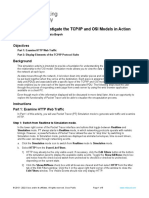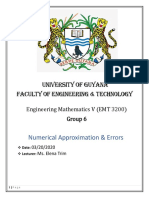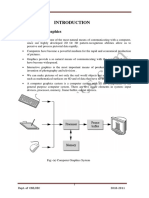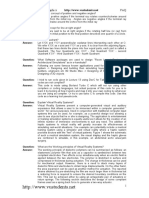Android OpenGL ES 1.0
Android OpenGL ES 1.0
Uploaded by
Cristhian AroCopyright:
Available Formats
Android OpenGL ES 1.0
Android OpenGL ES 1.0
Uploaded by
Cristhian AroCopyright
Available Formats
Share this document
Did you find this document useful?
Is this content inappropriate?
Copyright:
Available Formats
Android OpenGL ES 1.0
Android OpenGL ES 1.0
Uploaded by
Cristhian AroCopyright:
Available Formats
OpenGL ES 1.
0 | Android Developers
3/27/12 8:14 PM
Tutorials:
OpenGL ES 1.0
This tutorial shows you how to create a simple Android
application that uses the OpenGL ES 1.0 API to perform some
basic graphics operations. You'll learn how to:
Create an activity using GLSurfaceView and
GLSurfaceView.Renderer
Create and draw a graphic object
Define a projection to correct for screen geometry
Define a camera view
Rotate a graphic object
Make graphics touch-interactive
The Android framework supports both the OpenGL ES 1.0/1.1
and OpenGL ES 2.0 APIs. You should carefully consider which
version of the OpenGL ES API (1.0/1.1 or 2.0) is most
appropriate for your needs. For more information, see Choosing
an OpenGL API Version. If you would prefer to use OpenGL ES
2.0, see the OpenGL ES 2.0 tutorial.
In this document
Create an Activity with GLSurfaceView
Draw a Shape on GLSurfaceView
Define a Triangle
Draw the Triangle
Apply Projection and Camera Views
Add Motion
Respond to Touch Events
Related Samples
API Demos - graphics
OpenGL ES 1.0 Sample
TouchRotateActivity
See also
3D with OpenGL
OpenGL ES 2.0
Before you start, you should understand how to create a basic Android application. If you do not know how to create an app,
follow the Hello World Tutorial to familiarize yourself with the process.
Create an Activity with GLSurfaceView
To get started using OpenGL, you must implement both a GLSurfaceView and a GLSurfaceView.Renderer. The
GLSurfaceView is the main view type for applications that use OpenGL and the GLSurfaceView.Renderer controls
what is drawn within that view. (For more information about these classes, see the 3D with OpenGL document.)
To create an activity using GLSurfaceView:
1. Start a new Android project that targets Android 1.6 (API Level 4) or higher.
2. Name the project HelloOpenGLES10 and make sure it includes an activity called HelloOpenGLES10.
3. Modify the HelloOpenGLES10 class as follows:
package com.example.android.apis.graphics;
import android.app.Activity;
import android.content.Context;
import android.opengl.GLSurfaceView;
http://developer.android.com/resources/tutorials/opengl/opengl-es10.html
Page 1 of 9
OpenGL ES 1.0 | Android Developers
3/27/12 8:14 PM
import android.os.Bundle;
public class HelloOpenGLES10 extends Activity {
private GLSurfaceView mGLView;
@Override
public void onCreate(Bundle savedInstanceState) {
super.onCreate(savedInstanceState);
// Create a GLSurfaceView instance and set it
// as the ContentView for this Activity.
mGLView = new HelloOpenGLES10SurfaceView(this);
setContentView(mGLView);
}
@Override
protected void onPause() {
super.onPause();
// The following call pauses the rendering thread.
// If your OpenGL application is memory intensive,
// you should consider de-allocating objects that
// consume significant memory here.
mGLView.onPause();
}
@Override
protected void onResume() {
super.onResume();
// The following call resumes a paused rendering thread.
// If you de-allocated graphic objects for onPause()
// this is a good place to re-allocate them.
mGLView.onResume();
}
}
class HelloOpenGLES10SurfaceView extends GLSurfaceView {
public HelloOpenGLES10SurfaceView(Context context){
super(context);
// Set the Renderer for drawing on the GLSurfaceView
setRenderer(new HelloOpenGLES10Renderer());
}
}
Note: You will get a compile error for the HelloOpenGLES10Renderer class reference. That's expected; you will
fix this error in the next step.
As shown above, this activity uses a single GLSurfaceView for its view. Notice that this activity implements crucial
lifecycle callbacks for pausing and resuming its work.
The HelloOpenGLES10SurfaceView class in this example code above is just a thin wrapper for an instance of
GLSurfaceView and is not strictly necessary for this example. However, if you want your application to monitor and
http://developer.android.com/resources/tutorials/opengl/opengl-es10.html
Page 2 of 9
OpenGL ES 1.0 | Android Developers
3/27/12 8:14 PM
respond to touch screen eventsand we are guessing you doyou must extend GLSurfaceView to add touch event
listeners, which you will learn how to do in the Reponding to Touch Events section.
In order to draw graphics in the GLSurfaceView, you must define an implementation of GLSurfaceView.Renderer.
In the next step, you create a renderer class to complete this OpenGL application.
4. Create a new file for the following class HelloOpenGLES10Renderer, which implements the
GLSurfaceView.Renderer interface:
package com.example.android.apis.graphics;
import javax.microedition.khronos.egl.EGLConfig;
import javax.microedition.khronos.opengles.GL10;
import android.opengl.GLSurfaceView;
public class HelloOpenGLES10Renderer implements GLSurfaceView.Renderer {
public void onSurfaceCreated(GL10 gl, EGLConfig config) {
// Set the background frame color
gl.glClearColor(0.5f, 0.5f, 0.5f, 1.0f);
}
public void onDrawFrame(GL10 gl) {
// Redraw background color
gl.glClear(GL10.GL_COLOR_BUFFER_BIT | GL10.GL_DEPTH_BUFFER_BIT);
}
public void onSurfaceChanged(GL10 gl, int width, int height) {
gl.glViewport(0, 0, width, height);
}
}
This minimal implementation of GLSurfaceView.Renderer provides the code structure needed to use OpenGL
drawing methods:
onSurfaceCreated() is called once to set up the GLSurfaceView environment.
onDrawFrame() is called for each redraw of the GLSurfaceView.
onSurfaceChanged() is called if the geometry of the GLSurfaceView changes, for example when the device's
screen orientation changes.
For more information about these methods, see the 3D with OpenGL document.
The code example above creates a simple Android application that displays a grey screen using OpenGL ES 1.0 calls. While
this application does not do anything very interesting, by creating these classes, you have layed the foundation needed to
start drawing graphic elements with OpenGL ES 1.0.
If you are familiar with the OpenGL ES APIs, these classes should give you enough information to use the OpenGL ES 1.0
API and create graphics. However, if you need a bit more help getting started with OpenGL, head on to the next sections for
a few more hints.
Draw a Shape on GLSurfaceView
http://developer.android.com/resources/tutorials/opengl/opengl-es10.html
Page 3 of 9
OpenGL ES 1.0 | Android Developers
3/27/12 8:14 PM
Once you have implemented a GLSurfaceView.Renderer, the next step is to draw something with it. This section shows
you how to define and draw a triangle.
Define a Triangle
OpenGL allows you to define objects using coordinates in three-dimensional space. So, before you can draw a triangle, you
must define its coordinates. In OpenGL, the typical way to do this is to define a vertex array for the coordinates.
By default, OpenGL ES assumes a coordinate system where [0,0,0] (X,Y,Z) specifies the center of the GLSurfaceView
frame, [1,1,0] is the top right corner of the frame and [-1,-1,0] is bottom left corner of the frame.
To define a vertex array for a triangle:
1. In your HelloOpenGLES10Renderer class, add new member variable to contain the vertices of a triangle shape:
private FloatBuffer triangleVB;
2. Create a method, initShapes() which populates this member variable:
private void initShapes(){
float triangleCoords[] = {
// X, Y, Z
-0.5f, -0.25f, 0,
0.5f, -0.25f, 0,
0.0f, 0.559016994f, 0
};
// initialize vertex Buffer for triangle
ByteBuffer vbb = ByteBuffer.allocateDirect(
// (# of coordinate values * 4 bytes per float)
triangleCoords.length * 4);
vbb.order(ByteOrder.nativeOrder());// use the device hardware's native byte
order
triangleVB = vbb.asFloatBuffer();
the ByteBuffer
triangleVB.put(triangleCoords);
triangleVB.position(0);
coordinate
// create a floating point buffer from
// add the coordinates to the FloatBuffer
// set the buffer to read the first
}
This method defines a two-dimensional triangle with three equal sides.
3. Modify your onSurfaceCreated() method to initialize your triangle:
public void onSurfaceCreated(GL10 gl, EGLConfig config) {
// Set the background frame color
gl.glClearColor(0.5f, 0.5f, 0.5f, 1.0f);
// initialize the triangle vertex array
initShapes();
}
http://developer.android.com/resources/tutorials/opengl/opengl-es10.html
Page 4 of 9
OpenGL ES 1.0 | Android Developers
3/27/12 8:14 PM
Caution: Shapes and other static objects should be initialized once in your onSurfaceCreated() method for best
performance. Avoid initializing the new objects in onDrawFrame(), as this causes the system to re-create the
objects for every frame redraw and slows down your application.
You have now defined a triangle shape, but if you run the application, nothing appears. What?! You also have to tell OpenGL
to draw the triangle, which you'll do in the next section.
Draw the Triangle
Before you can draw your triangle, you must tell OpenGL that you are using vertex arrays. After that setup step, you can call
the drawing APIs to display the triangle.
To draw the triangle:
1. Add the glEnableClientState() method to the end of onSurfaceCreated() to enable vertex arrays.
// Enable use of vertex arrays
gl.glEnableClientState(GL10.GL_VERTEX_ARRAY);
At this point, you are ready to draw the triangle object in the OpenGL view.
2. Add the following code to the end of your onDrawFrame() method to draw the triangle.
// Draw the triangle
gl.glColor4f(0.63671875f, 0.76953125f, 0.22265625f, 0.0f);
gl.glVertexPointer(3, GL10.GL_FLOAT, 0, triangleVB);
gl.glDrawArrays(GL10.GL_TRIANGLES, 0, 3);
3. Run the app! Your application should look something like this:
Figure 1. Triangle drawn without a projection or camera view.
There are a few problems with this example. First of all, it is not going to impress your friends. Secondly, the triangle is a bit
squashed and changes shape when you change the screen orientation of the device. The reason the shape is skewed is due
to the fact that the object is being rendered in a frame which is not perfectly square. You'll fix that problem using a projection
and camera view in the next section.
http://developer.android.com/resources/tutorials/opengl/opengl-es10.html
Page 5 of 9
OpenGL ES 1.0 | Android Developers
3/27/12 8:14 PM
Lastly, because the triangle is stationary, the system is redrawing the object repeatedly in exactly the same place, which is
not the most efficient use of the OpenGL graphics pipeline. In the Add Motion section, you'll make this shape rotate and
justify this use of processing power.
Apply Projection and Camera View
One of the basic problems in displaying graphics is that Android device displays are typically not square and, by default,
OpenGL happily maps a perfectly square, uniform coordinate system onto your typically non-square screen. To solve this
problem, you can apply an OpenGL projection mode and camera view (eye point) to transform the coordinates of your
graphic objects so they have the correct proportions on any display. For more information about OpenGL coordinate
mapping, see Mapping Coordinates for Drawn Objects.
To apply projection and camera view transformations to your triangle:
1. Modify your onSurfaceChanged() method to enable GL10.GL_PROJECTION mode, calculate the screen ratio and
apply the ratio as a transformation of the object coordinates.
public void onSurfaceChanged(GL10 gl, int width, int height) {
gl.glViewport(0, 0, width, height);
// make adjustments for screen ratio
float ratio = (float) width / height;
gl.glMatrixMode(GL10.GL_PROJECTION);
gl.glLoadIdentity();
// set matrix to projection mode
// reset the matrix to its default
gl.glFrustumf(-ratio, ratio, -1, 1, 3, 7);
// apply the projection matrix
state
}
2. Next, modify your onDrawFrame() method to apply the GL_MODELVIEW mode and set a view point using
GLU.gluLookAt().
public void onDrawFrame(GL10 gl) {
// Redraw background color
gl.glClear(GL10.GL_COLOR_BUFFER_BIT | GL10.GL_DEPTH_BUFFER_BIT);
// Set GL_MODELVIEW transformation mode
gl.glMatrixMode(GL10.GL_MODELVIEW);
gl.glLoadIdentity();
// reset the matrix to its default state
// When using GL_MODELVIEW, you must set the view point
GLU.gluLookAt(gl, 0, 0, -5, 0f, 0f, 0f, 0f, 1.0f, 0.0f);
// Draw the triangle
...
}
3. Run the updated application and you should see something like this:
http://developer.android.com/resources/tutorials/opengl/opengl-es10.html
Page 6 of 9
OpenGL ES 1.0 | Android Developers
3/27/12 8:14 PM
Figure 2. Triangle drawn with a projection and camera view applied.
Now that you have applied this transformation, the triangle has three equal sides, instead of the squashed triangle in the
earlier version.
Add Motion
While it may be an interesting exercise to create static graphic objects with OpenGL ES, chances are you want at least some
of your objects to move. In this section, you'll add motion to your triangle by rotating it.
To add rotation to your triangle:
1. Modify your onDrawFrame() method to rotate the triangle object:
public void onDrawFrame(GL10 gl) {
...
// When using GL_MODELVIEW, you must set the view point
GLU.gluLookAt(gl, 0, 0, -5, 0f, 0f, 0f, 0f, 1.0f, 0.0f);
// Create a rotation for the triangle
long time = SystemClock.uptimeMillis() % 4000L;
float angle = 0.090f * ((int) time);
gl.glRotatef(angle, 0.0f, 0.0f, 1.0f);
// Draw the triangle
...
}
2. Run the application and your triangle should rotate around its center.
Respond to Touch Events
Making objects move according to a preset program like the rotating triangle is useful for getting some attention, but what if
http://developer.android.com/resources/tutorials/opengl/opengl-es10.html
Page 7 of 9
OpenGL ES 1.0 | Android Developers
3/27/12 8:14 PM
you want to have users interact with your OpenGL graphics? In this section, you'll learn how listen for touch events to let
users interact with objects in your HelloOpenGLES10SurfaceView.
The key to making your OpenGL application touch interactive is expanding your implementation of GLSurfaceView to
override the onTouchEvent() to listen for touch events. Before you do that, however, you'll modify the renderer class to
expose the rotation angle of the triangle. Afterwards, you'll modify the HelloOpenGLES10SurfaceView to process touch
events and pass that data to your renderer.
To make your triangle rotate in response to touch events:
1. Modify your HelloOpenGLES10Renderer class to include a new, public member so that your
HelloOpenGLES10SurfaceView class is able to pass new rotation values your renderer:
public float mAngle;
2. In your onDrawFrame() method, comment out the code that generates an angle and replace the angle variable with
mAngle.
// Create a rotation for the triangle (Boring! Comment this out:)
// long time = SystemClock.uptimeMillis() % 4000L;
// float angle = 0.090f * ((int) time);
// Use the mAngle member as the rotation value
gl.glRotatef(mAngle, 0.0f, 0.0f, 1.0f);
3. In your HelloOpenGLES10SurfaceView class, add the following member variables.
private
private
private
private
final float TOUCH_SCALE_FACTOR = 180.0f / 320;
HelloOpenGLES10Renderer mRenderer;
float mPreviousX;
float mPreviousY;
4. In the constructor method for HelloOpenGLES10SurfaceView, set the mRenderer member so you have a handle to
pass in rotation input and set the render mode to RENDERMODE_WHEN_DIRTY.
public HelloOpenGLES10SurfaceView(Context context){
super(context);
// set the mRenderer member
mRenderer = new HelloOpenGLES10Renderer();
setRenderer(mRenderer);
// Render the view only when there is a change
setRenderMode(GLSurfaceView.RENDERMODE_WHEN_DIRTY);
}
5. In your HelloOpenGLES10SurfaceView class, override the onTouchEvent() method to listen for touch events and
pass them to your renderer.
@Override
public boolean onTouchEvent(MotionEvent e) {
// MotionEvent reports input details from the touch screen
// and other input controls. In this case, you are only
// interested in events where the touch position changed.
http://developer.android.com/resources/tutorials/opengl/opengl-es10.html
Page 8 of 9
OpenGL ES 1.0 | Android Developers
3/27/12 8:14 PM
float x = e.getX();
float y = e.getY();
switch (e.getAction()) {
case MotionEvent.ACTION_MOVE:
float dx = x - mPreviousX;
float dy = y - mPreviousY;
// reverse direction of rotation above the mid-line
if (y > getHeight() / 2) {
dx = dx * -1 ;
}
// reverse direction of rotation to left of the mid-line
if (x < getWidth() / 2) {
dy = dy * -1 ;
}
mRenderer.mAngle += (dx + dy) * TOUCH_SCALE_FACTOR;
requestRender();
}
mPreviousX = x;
mPreviousY = y;
return true;
}
Note: Touch events return pixel coordinates which are not the same as OpenGL coordinates. Touch coordinate [0,0]
is the bottom-left of the screen and the highest value [max_X, max_Y] is the top-right corner of the screen. To match
touch events to OpenGL graphic objects, you must translate touch coordinates into OpenGL coordinates.
6. Run the application and drag your finger or cursor around the screen to rotate the triangle.
For another example of OpenGL touch event functionality, see TouchRotateActivity.
" Back to Tutorials
! Go to top
Except as noted, this content is licensed under Creative Commons Attribution 2.5. For details and restrictions, see the Content
License.
Privacy & Terms - Brand Guidelines - Report Document Issues
http://developer.android.com/resources/tutorials/opengl/opengl-es10.html
Page 9 of 9
You might also like
- Packet Tracer - Investigate The TCP/IP and OSI Models in ActionNo ratings yetPacket Tracer - Investigate The TCP/IP and OSI Models in Action5 pages
- KLE Technological University Hubballi: A Minor Project Report OnNo ratings yetKLE Technological University Hubballi: A Minor Project Report On18 pages
- Numerical Solution of Algebraic and Transcendental Equation. - AnnotatedNo ratings yetNumerical Solution of Algebraic and Transcendental Equation. - Annotated5 pages
- Understanding The Need, Basic Guidelines, Content & Process For Value EducationNo ratings yetUnderstanding The Need, Basic Guidelines, Content & Process For Value Education17 pages
- Program Evaluation and Review Technique (PERT)No ratings yetProgram Evaluation and Review Technique (PERT)12 pages
- Fire Fighting Robotic Vehicle: Project OnNo ratings yetFire Fighting Robotic Vehicle: Project On25 pages
- Economic Order Quantity (EOQ) Model: Dr. Rakesh KumarNo ratings yetEconomic Order Quantity (EOQ) Model: Dr. Rakesh Kumar6 pages
- Build Project in Code Composer Studio Version 5100% (1)Build Project in Code Composer Studio Version 512 pages
- K L University Freshman Engineering Department: A Project Based Lab Report On Rank ListNo ratings yetK L University Freshman Engineering Department: A Project Based Lab Report On Rank List16 pages
- Emt 3200 - Group 6 - Numerical Approximations & Errors - Report100% (1)Emt 3200 - Group 6 - Numerical Approximations & Errors - Report24 pages
- Ex06 - To Create An Ansible Playbook For A Single Web Application InfrastructureNo ratings yetEx06 - To Create An Ansible Playbook For A Single Web Application Infrastructure3 pages
- X (Age Youth, Income Medium, Student Yes, Credit Rating Fair)No ratings yetX (Age Youth, Income Medium, Student Yes, Credit Rating Fair)2 pages
- Building An Online Shopping Cart Using C Sharp Part 2No ratings yetBuilding An Online Shopping Cart Using C Sharp Part 217 pages
- Mentor Graphics Modelsim SE 10.1c - RuTracker - Org (Ex TorrentsNo ratings yetMentor Graphics Modelsim SE 10.1c - RuTracker - Org (Ex Torrents5 pages
- Classical Programming Interview QuestionsNo ratings yetClassical Programming Interview Questions14 pages
- The D Operator - Differential - Calculus - Maths Reference With Worked ExamplesNo ratings yetThe D Operator - Differential - Calculus - Maths Reference With Worked Examples7 pages
- OpenGL ES For Android Graphics ProgrammingNo ratings yetOpenGL ES For Android Graphics Programming6 pages
- 1.1 Introduction To Computer Graphics: User InterfacesNo ratings yet1.1 Introduction To Computer Graphics: User Interfaces13 pages
- Lift Over Bridge Presentation 15129145 Comp Graphics Final Project60% (5)Lift Over Bridge Presentation 15129145 Comp Graphics Final Project16 pages
- Chapter 2 - Graphics Programming With JOGLNo ratings yetChapter 2 - Graphics Programming With JOGL31 pages
- Graphics Programming Using Opengl: Vinod Pathangay Ph. D. Scholar Visualization and Perception Lab Iit MadrasNo ratings yetGraphics Programming Using Opengl: Vinod Pathangay Ph. D. Scholar Visualization and Perception Lab Iit Madras27 pages
- Gpu - How Does OpenGL Work at The Lowest Level - Stack OverflowNo ratings yetGpu - How Does OpenGL Work at The Lowest Level - Stack Overflow4 pages
- PC-DMIS 2013 Release Enterprise Metrology Solutions - Release NotesNo ratings yetPC-DMIS 2013 Release Enterprise Metrology Solutions - Release Notes36 pages
- CS602 Short Questions Answer WWW Vustudents NetNo ratings yetCS602 Short Questions Answer WWW Vustudents Net13 pages
- PDF AR and VR Using the WebXR API Learn to Create Immersive Content with WebGL Three js and A Frame 1st Edition Rakesh Baruah download100% (2)PDF AR and VR Using the WebXR API Learn to Create Immersive Content with WebGL Three js and A Frame 1st Edition Rakesh Baruah download62 pages
- Packet Tracer - Investigate The TCP/IP and OSI Models in ActionPacket Tracer - Investigate The TCP/IP and OSI Models in Action
- KLE Technological University Hubballi: A Minor Project Report OnKLE Technological University Hubballi: A Minor Project Report On
- Numerical Solution of Algebraic and Transcendental Equation. - AnnotatedNumerical Solution of Algebraic and Transcendental Equation. - Annotated
- Understanding The Need, Basic Guidelines, Content & Process For Value EducationUnderstanding The Need, Basic Guidelines, Content & Process For Value Education
- Economic Order Quantity (EOQ) Model: Dr. Rakesh KumarEconomic Order Quantity (EOQ) Model: Dr. Rakesh Kumar
- K L University Freshman Engineering Department: A Project Based Lab Report On Rank ListK L University Freshman Engineering Department: A Project Based Lab Report On Rank List
- Emt 3200 - Group 6 - Numerical Approximations & Errors - ReportEmt 3200 - Group 6 - Numerical Approximations & Errors - Report
- Ex06 - To Create An Ansible Playbook For A Single Web Application InfrastructureEx06 - To Create An Ansible Playbook For A Single Web Application Infrastructure
- X (Age Youth, Income Medium, Student Yes, Credit Rating Fair)X (Age Youth, Income Medium, Student Yes, Credit Rating Fair)
- Building An Online Shopping Cart Using C Sharp Part 2Building An Online Shopping Cart Using C Sharp Part 2
- Mentor Graphics Modelsim SE 10.1c - RuTracker - Org (Ex TorrentsMentor Graphics Modelsim SE 10.1c - RuTracker - Org (Ex Torrents
- The D Operator - Differential - Calculus - Maths Reference With Worked ExamplesThe D Operator - Differential - Calculus - Maths Reference With Worked Examples
- JavaScript Patterns JumpStart Guide (Clean up your JavaScript Code)From EverandJavaScript Patterns JumpStart Guide (Clean up your JavaScript Code)
- 1.1 Introduction To Computer Graphics: User Interfaces1.1 Introduction To Computer Graphics: User Interfaces
- Lift Over Bridge Presentation 15129145 Comp Graphics Final ProjectLift Over Bridge Presentation 15129145 Comp Graphics Final Project
- Graphics Programming Using Opengl: Vinod Pathangay Ph. D. Scholar Visualization and Perception Lab Iit MadrasGraphics Programming Using Opengl: Vinod Pathangay Ph. D. Scholar Visualization and Perception Lab Iit Madras
- Gpu - How Does OpenGL Work at The Lowest Level - Stack OverflowGpu - How Does OpenGL Work at The Lowest Level - Stack Overflow
- PC-DMIS 2013 Release Enterprise Metrology Solutions - Release NotesPC-DMIS 2013 Release Enterprise Metrology Solutions - Release Notes
- PDF AR and VR Using the WebXR API Learn to Create Immersive Content with WebGL Three js and A Frame 1st Edition Rakesh Baruah downloadPDF AR and VR Using the WebXR API Learn to Create Immersive Content with WebGL Three js and A Frame 1st Edition Rakesh Baruah download

























































































